November 1942
North Africa: Operation Torch
(Posted November 2002)
November 8 1942
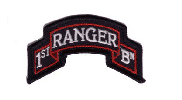 Operation Torch was the code name for the Allied invasion of North Africa. It was designed to end the German presence on that continent. This invasion marked the first battle experience as a battalion for the 1st Rangers, as an independent American unit. At this point there was only one battalion of Rangers. As they moved from mission, to successful mission in North Africa, it was later decided to create two more battalions, but that story is yet to come.
Operation Torch was the code name for the Allied invasion of North Africa. It was designed to end the German presence on that continent. This invasion marked the first battle experience as a battalion for the 1st Rangers, as an independent American unit. At this point there was only one battalion of Rangers. As they moved from mission, to successful mission in North Africa, it was later decided to create two more battalions, but that story is yet to come.
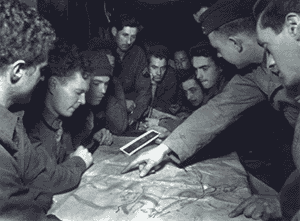 Months of preparation had gone into getting the Rangers and machines rehearsed for open the seaports and land-masses to the Allies to bring in troops, supplies, armor, and planes, thus enabling them to eventually launch their attack on the European continent. From Africa, the Allies would move north through Sicily, into Italy, launch the eventual invasion on the shores of Normandy in France, and on into Germany. The success of the Allies in the European Theater of war was contingent on the successful execution of Operation Torch.
Months of preparation had gone into getting the Rangers and machines rehearsed for open the seaports and land-masses to the Allies to bring in troops, supplies, armor, and planes, thus enabling them to eventually launch their attack on the European continent. From Africa, the Allies would move north through Sicily, into Italy, launch the eventual invasion on the shores of Normandy in France, and on into Germany. The success of the Allies in the European Theater of war was contingent on the successful execution of Operation Torch.
The invasion involved a three-stage plan. The first was to get a strong foothold in North Africa. The second was moving out and gaining control over North French Africa. The third was to move east across Libya to attack the Germans and Italians from the rear, which was already engaged in a conflict with British troops.
The main objective of the initial assault was to capture and secure control of Oran, a seaport of some 400,000 people. To accomplish this, the 1st Ranger Battalion was attached to the Center Task Force under Major General Lloyd Fredendall. The Rangers were more specifically attached to the 1st Infantry Division under Terry Allen.
Enemy resistance was anticipated to be light, but it was discovered that German forces were occupying the port town of Arzew (which lay twenty miles east of Oran). This meant that landing craft carrying the assault troops could be destroyed if, and when they were spotted. This is where the Rangers came into play. There were two coastal batteries at Arzew, and it was decided that a simultaneous attack of the companies of the 1st Ranger Battalion was the best way to execute this special operation. Destroying these coastal batteries was paramount for the safe landing of the troops and heavy equipment waiting off shore.
Heavy artillery dominated the cliffs over the port of Arzew. The port itself consisted of two concrete jetties running a full mile into the sea that then joined to form a narrow opening, which could be closed into the port.
On the harbor point was another gun battery named "Ford de La Pointe". Here guns were aimed seaward to ward off infiltration by boat. Infiltration into the port of Arzew could not be accomplished until these gun batteries were secured. This became the job for the Rangers who were to move in ahead of the task force (spearhead the invasion as they became famous for doing in many assault landings to come), secure the gun batteries, and make way for the troops waiting offshore to land with their heavy equipment.
The Rangers spearheaded this invasion by executing an amphibious landing on the North African shores, then infiltrating behind enemy lines and destroying artillery aimed on the beach. The Rangers carried out this mission in two separate landings. One force of companies, led by Major Dammer, would go directly into the port of Arzew. A second force under Lieutenant Colonel Darby, would attack the high ground. This would be accomplished by landing on the rocky shores and scaling the cliff to secure the battery above.
A deceptive convoy of ships was sent out into the Mediterranean Sea to distract attention from the infiltrating Rangers. The convoy led the Germans to believe the assault was to occur elsewhere. The plan worked, the Rangers landed, infiltrated behind enemy lines, secured their objectives by eliminating the gun batteries aimed at the sea and securing the port, thus enabling the awaiting Allied forces to land and take Arzew by complete surprise.
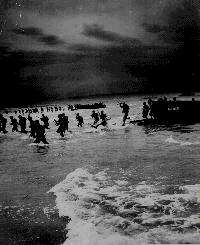 The 1st Battalion rode in their landing craft, the British LCAs, to reach the port of Arzew and the surrounding beaches. The LCAs arrived at Arzew on November 8, 1942 at 0200 hours. The Rangers approaching the main port remained uncertain of several factors. The greatest of these was whether the the end of the jetties would be open, or closed. But, as their LCAs approached the port, a British submarine pulled up beside them and alerted Dammer and his Rangers, that the closure at the end of the jetties was open and their trip into port would be without complication.
The 1st Battalion rode in their landing craft, the British LCAs, to reach the port of Arzew and the surrounding beaches. The LCAs arrived at Arzew on November 8, 1942 at 0200 hours. The Rangers approaching the main port remained uncertain of several factors. The greatest of these was whether the the end of the jetties would be open, or closed. But, as their LCAs approached the port, a British submarine pulled up beside them and alerted Dammer and his Rangers, that the closure at the end of the jetties was open and their trip into port would be without complication.
Additionally, these same infiltrating Rangers were relieved to find their approach on the docks was an easier task than anticipated. From the aerial shots of the port, the only information the Rangers had to go on, it was unknown how high the docks would actually be from the water. Much to their surprise, the docks were very low and they were able to hop out of their landing craft onto the docks with ease and move on to their designated missions. Once on the dock, the Rangers moved in to secure the fort within 15 minutes.
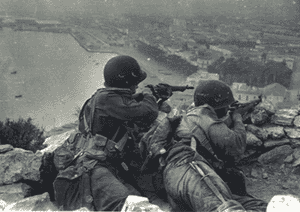 Meanwhile, the force under Darby charged the embankment, scaled the steep rocky cliffs, and seized the gun batteries on the high ground aimed out to sea. Flares were fired from Dammer’s men at the fort in the harbor, signaling to Darby in the high ground, that the fort had been secured. Once the Rangers destroyed the artillery, they signaled the bulk of the troops and navy waiting offshore, that it was safe to land and secure the area.
Meanwhile, the force under Darby charged the embankment, scaled the steep rocky cliffs, and seized the gun batteries on the high ground aimed out to sea. Flares were fired from Dammer’s men at the fort in the harbor, signaling to Darby in the high ground, that the fort had been secured. Once the Rangers destroyed the artillery, they signaled the bulk of the troops and navy waiting offshore, that it was safe to land and secure the area.
It is interesting to note here, that ironically enough, the Rangers had a plan of communication involving a series of designated colored flares. When Darby’s group approached shore, a boatload of Rangers was literally dumped into the sea when the landing apparatus malfunctioned. The flares intended to communicate the success of Darby and his Rangers in the high ground, sunk to the bottom of the sea in this mishap. When Darby did indeed secure the batteries on the high ground, he shot off the flares he had left to communicate his success to the waiting fleet offshore. The preplanned color scheme of flares was not available to Darby, as they lay at the bottom of the sea. Confused by the color of the flares, the troops offshore waited two hours before actually landing.
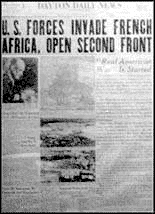 Operation Torch gave the Allies many advantages. With General Montgomery and the British to the east of Tunisia and now the U.S. to the west, Torch allowed the Allies to sandwich Rommel in Tunisia. This proved to be vital, because the Allies eventually surrounded and defeated Rommel in the battle of Tunisia in the summer of 1943. This in turn gave the Allies a solid base in the ports and airfields from which they would later launch the invasions of Sicily and Italy.
Operation Torch gave the Allies many advantages. With General Montgomery and the British to the east of Tunisia and now the U.S. to the west, Torch allowed the Allies to sandwich Rommel in Tunisia. This proved to be vital, because the Allies eventually surrounded and defeated Rommel in the battle of Tunisia in the summer of 1943. This in turn gave the Allies a solid base in the ports and airfields from which they would later launch the invasions of Sicily and Italy.
Torch also marked, up to that time, the largest amphibious operation in the history of warfare. More importantly, it marked the first big success of the war for the Allies, boosting morale and turning the tide of the war in favor of the Allied powers.
It is ironic to note here, that prior to their landing, the Rangers heard President Roosevelt announce over the airwaves, "Our valiant and courageous troops are now storming the beaches of North Africa." The Rangers heard this on the BBC before they ever boarded their assault crafts to invade Arzew, the very event that initiated the invasion of North Africa. Before ever executing the operation, the president announced the assault over international radio, and in essence alerted the German forces in North Africa to the invasion.
After the capture of Arzew, Ranger companies assisted in a continued clean-up of operations in nearby towns. The rest were sent down the beach from the town to set up bivouac. There was a cold wet storm rolling in and the Rangers found refuge in beach houses that had been inhabited by luxury vacationers on the shores of the Mediterranean. Here they stayed, trained, got haircuts and were re-supplied with personal affects. The houses had hard, cold stone floors, so although their lodging had been that of luxury to the occupants preceding them, they were now empty and the Rangers slept on the stone floors. They were issued mattress covers for which they had no mattresses. These became novelty items to trade with the Arab and French civilians of Arzew. They were often traded for French francs, as the Rangers had not been paid in the local currency. The locals used the mattress covers for pants and other various creations, the mere mention of what the civilians did with these covers elicits chuckles from the Rangers yet today.
References: Rangers in World War II, by Robert W. Black, 1st Battalion Rangers who were there, photos courtesy U.S. Army
If you have something to offer the timeline, please Contact Us
 DESCENDANTS OF WWII RANGERS, INC
DESCENDANTS OF WWII RANGERS, INC 